Gliomatosis peritonei with 18F-fluorodeoxyglucose accumulation and contrast enhancement secondary to immature teratoma: A case report
- Authors:
- Tsutomu Ohara
- Koji Yamanoi
- Yoshihide Inayama
- Jumpei Ogura
- Mie Sakai
- Haruka Suzuki
- Takahiro Hirayama
- Koji Yasumoto
- Ko Suginami
View Affiliations
Affiliations: Department of Obstetrics and Gynecology, Toyooka Public Hospital, Toyooka, Hyogo 668-8501, Japan
- Published online on: May 2, 2018 https://doi.org/10.3892/mco.2018.1618
-
Pages:
40-43
Metrics: Total
Views: 0 (Spandidos Publications: | PMC Statistics: )
Metrics: Total PDF Downloads: 0 (Spandidos Publications: | PMC Statistics: )
This article is mentioned in:
Abstract
Gliomatosis peritonei (GP) is a rare condition characterized by mature glial tissue implants widespread in the peritoneum, which is occasionally followed by treatment for immature teratoma (IM). The present study reported a case of GP with fluorodeoxyglucose (FDG) accumulation and contrast enhancement followed by treatment for IM. A 30‑year‑old female, 2‑gravida and 0‑para, underwent laparotomy with hysterectomy, bilateral salpingo‑oophorectomy, and partial omentectomy followed by four cycles of chemotherapy with bleomycin, etoposide, and cisplatin for IM (Grade 2) of stage IIIC. At the 6‑month follow‑up, computed tomography (CT) revealed a 1‑cm mass with contrast enhancement on splenic flexure. Positron‑emission tomography (PET)/CT revealed intense FDG accumulation at the same site. Although α‑fetoprotein, which was elevated preoperatively, remained normal, she was diagnosed with IM recurrence. The patient underwent three cycles of chemotherapy with paclitaxel, ifosfamide, and cisplatin, but the size, the degree of contrast enhancement and FDG accumulation of the mass did not change after chemotherapy. A diagnostic laparoscopy was performed. which revealed multiple small peritoneal implants, including a 1‑cm mass at the splenic flexure. The 1‑cm mass was dissected at the splenic flexure and some other implants. Mature well‑differentiated glial tissue with non‑atypia was identified in all tissue, and a diagnosis of GP was made. The patient is currently undergoing regular follow‑up. Few reports are available regarding FDG‑PET/CT imaging of GP. GP should be considered as the differential diagnosis of FDG‑avid mass followed by IM therapy. A laparoscopic diagnosis is useful to obtain an accurate diagnosis of GP.
View Figures |
Figure 1
|
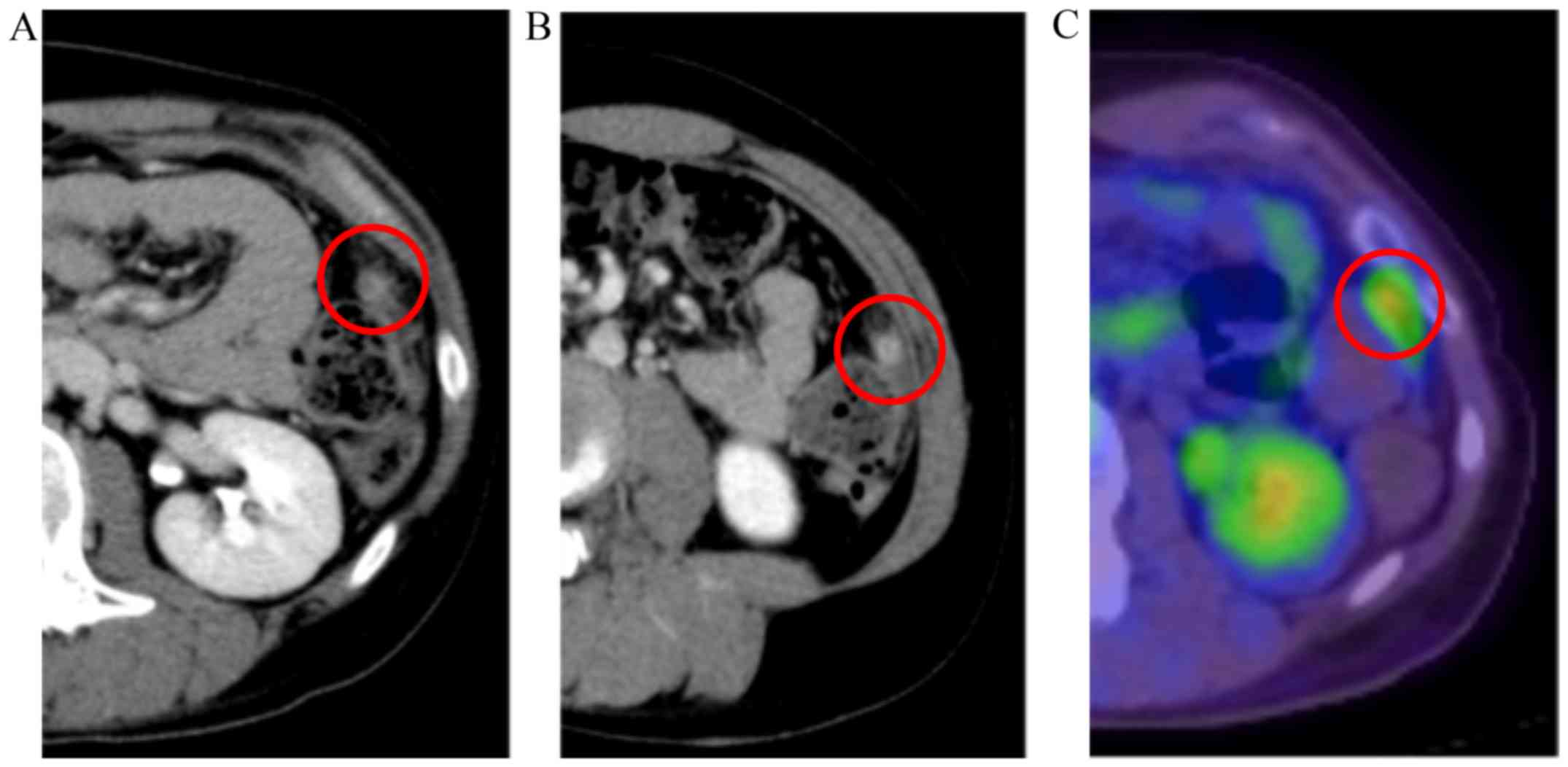 |
Figure 2
|
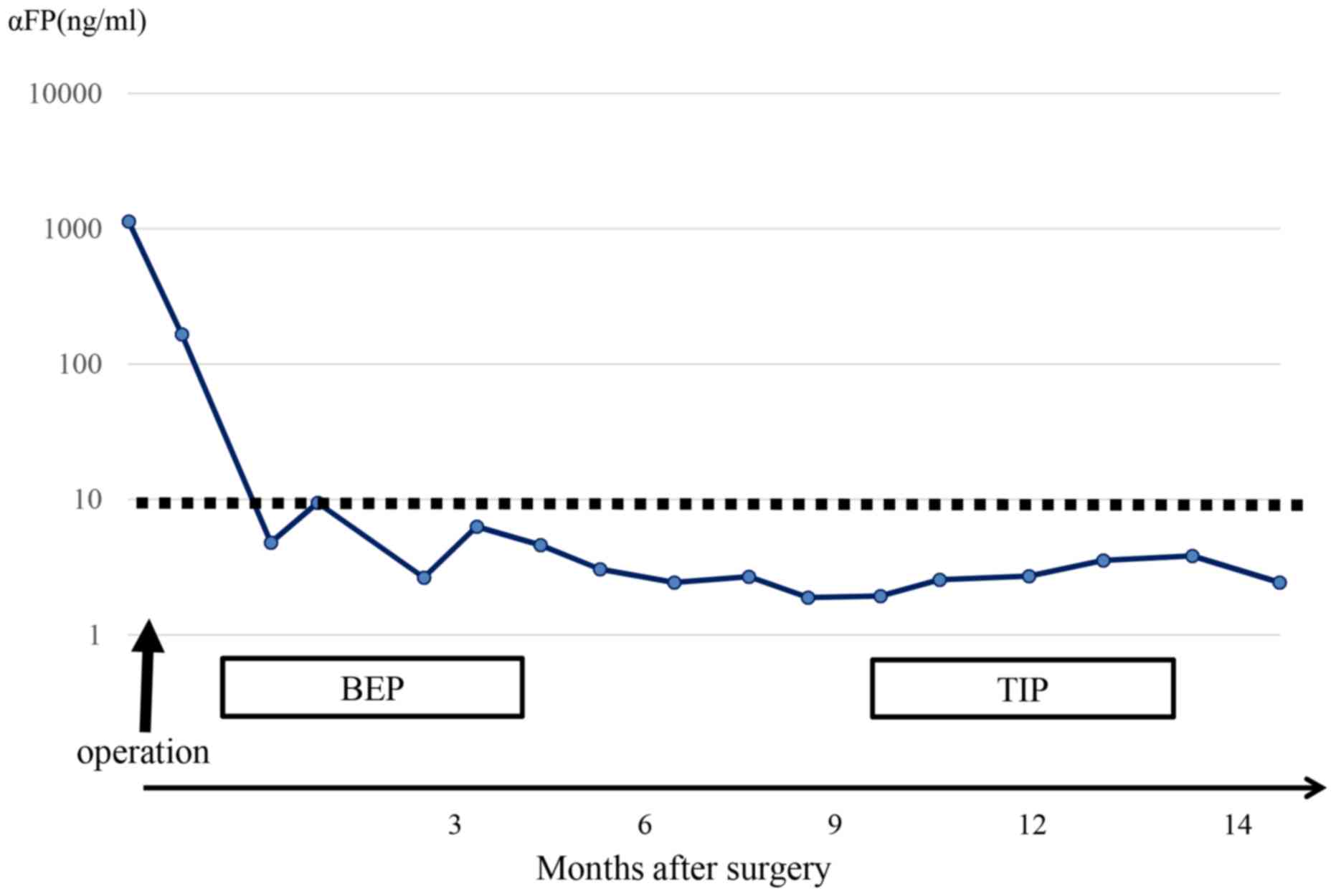 |
Figure 3
|
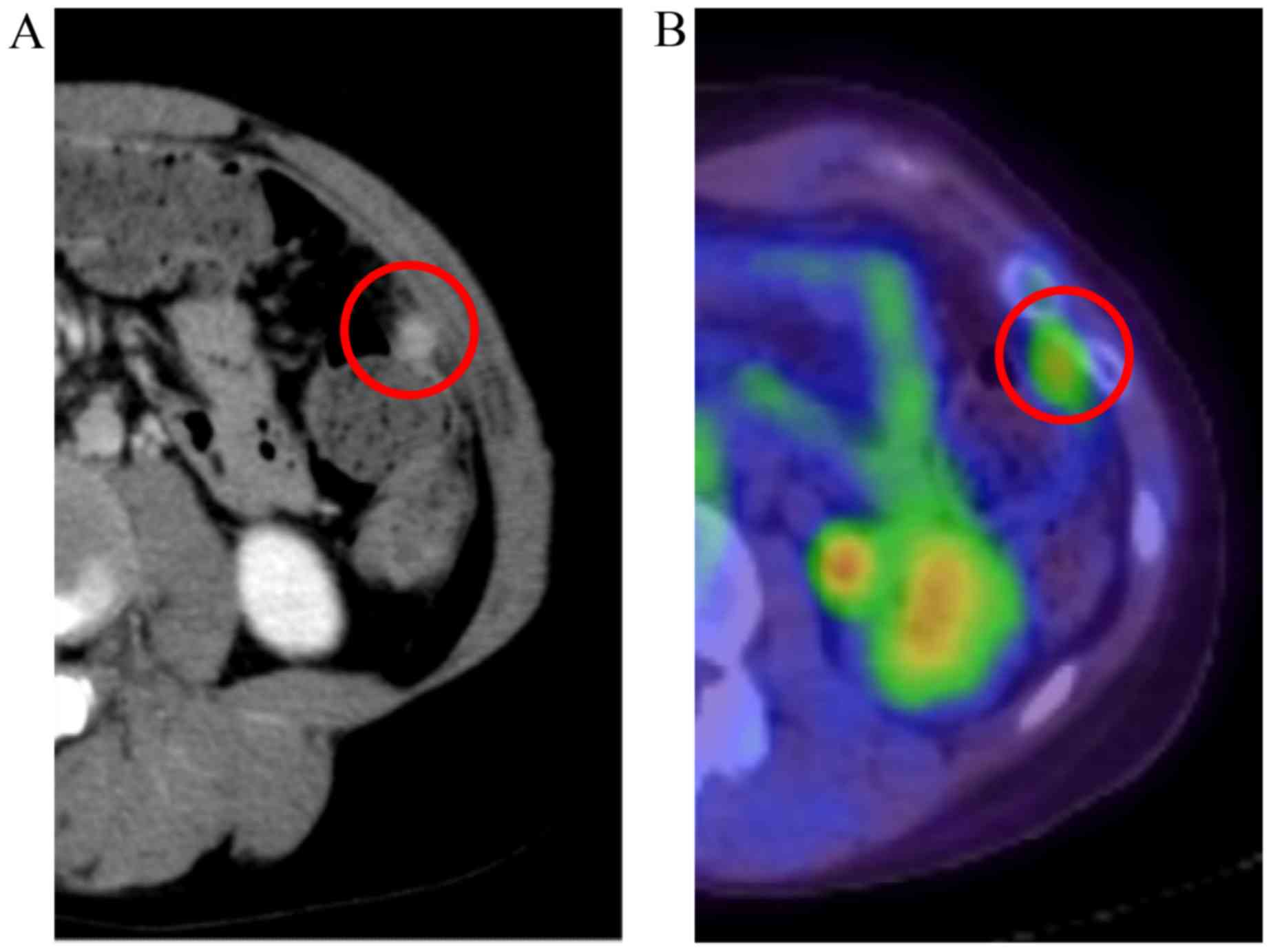 |
Figure 4
|
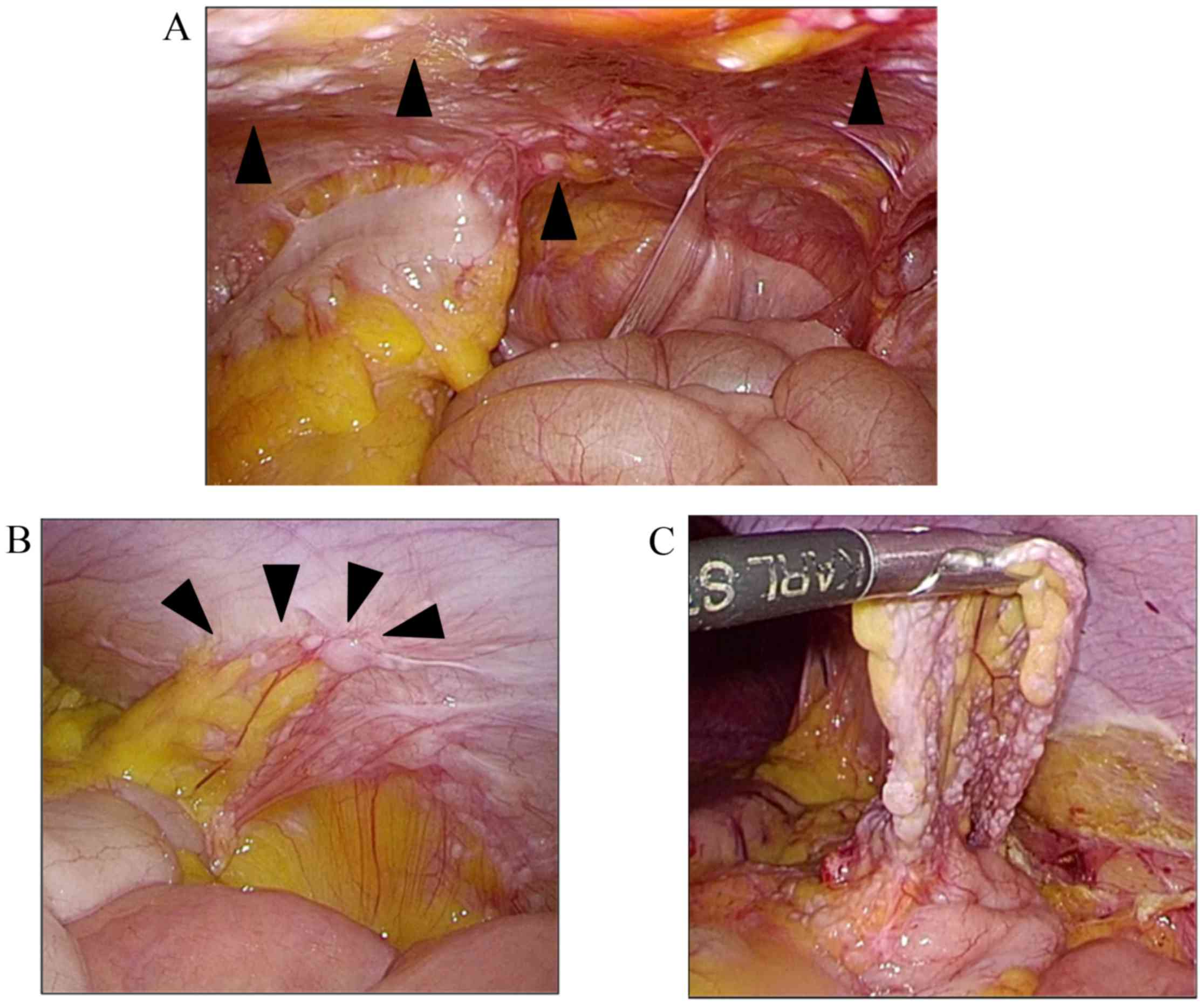 |
Figure 5
|
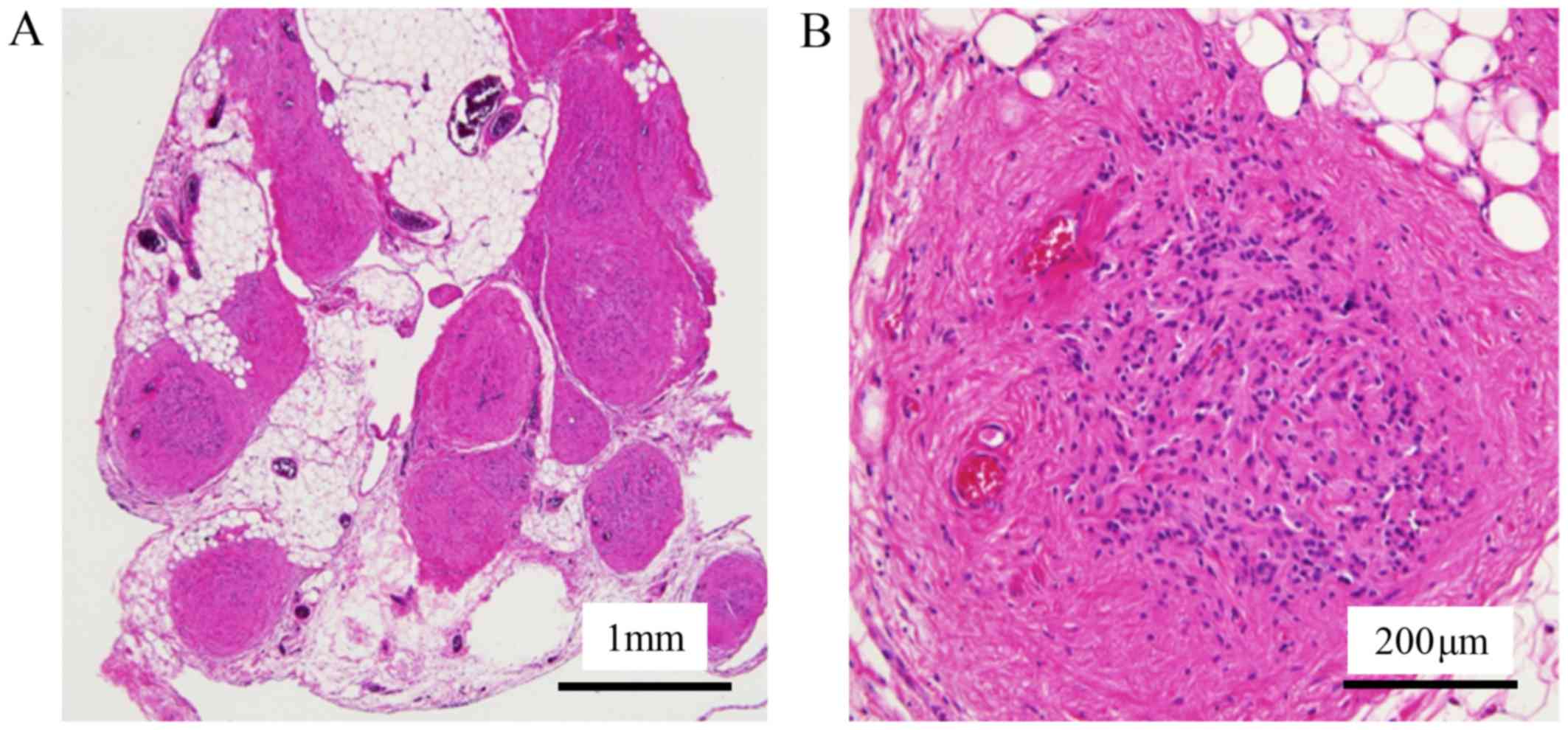 |
Figure 6
|
View References
|
1
|
Zalel Y, Piura B, Elchalal U, Czernobilsky
B, Antebi S and Dgani R: Diagnosis and management of malignant germ
cell ovarian tumors in young females. Int J Gynaecol Obstet.
55:1–10. 1996. View Article : Google Scholar : PubMed/NCBI
|
|
2
|
Williams S, Blessing JA, Liao SY, Ball H
and Hanjani P: Adjuvant therapy of ovarian germ cell tumors with
cisplatin, etoposide and bleomycin: A trial of the Gynecologic
Oncology Group. J Clin Oncol. 12:701–706. 1994. View Article : Google Scholar : PubMed/NCBI
|
|
3
|
Norris HJ, Zirkin HJ and Benson WL:
Immature (malignant) teratoma of the ovary: A clinical and
pathologic study of 58 cases. Cancer. 37:2359–2372. 1976.
View Article : Google Scholar : PubMed/NCBI
|
|
4
|
Mangili G, Scarfone G, Gadducci A,
Sigismondi C, Ferrandina G, Scibilia G, Vigano R, Tateo S, Villa A
and Lorusso D: Is adjuvant chemotherapy indicated in stage I pure
immature ovarian teratoma (IT)? Amulticentre Italian trial in
ovarian cancer (MITO-9). Gynecol Oncol. 119:48–52. 2010. View Article : Google Scholar : PubMed/NCBI
|
|
5
|
André F, Fizazi K, Culine S, Droz J,
Taupin P, Lhommé C, Terrier-Lacombe M and Théodore C: The growing
teratoma syndrome: Results of therapy and long-term follow-up of 33
patients. Eur J Cancer. 36:1389–1394. 2000. View Article : Google Scholar : PubMed/NCBI
|
|
6
|
Fortt RW and Mathie IK: Gliomatosis
peritonei caused by ovarian teratoma. J Clin Pathol. 22:348–353.
1969. View Article : Google Scholar : PubMed/NCBI
|
|
7
|
Yoon NR, Lee JW, Kim BG, Bae DS, Sohn I,
Sung CO and Song SY: Gliomatosis pertonei is associated with
frequent recurrence, but does not affect overall survival in
patients with ovarian immature teratoma. Vichows Arch. 461:299–304.
2012. View Article : Google Scholar
|
|
8
|
Gu P, Pan LL, Wu SQ, Sun L and Huang G:
CA125, PET alone, PET-CT, CT and MRI in diagnosing reccurent
ovarian carcinoma: A systematic review and meta-analysis. Eur J
Radiol. 71:164–174. 2009. View Article : Google Scholar : PubMed/NCBI
|
|
9
|
Beyer T, Townsend DW, Brun T, Kinahan PE,
Charron M, Roddy R, Jerin J, Young J, Byars L and Nutt R: A
combined PET/CT scanner for clinical oncology. J Nucl Med.
41:1369–1379. 2000.PubMed/NCBI
|
|
10
|
Oldan JD and Patel PS: Positron emission
tomography/computed tomography for gynecologic malignancies. Obstet
Gynecol Surv. 71:545–556. 2016. View Article : Google Scholar : PubMed/NCBI
|
|
11
|
Lavoie JM, Lacroix-Poisson F, Hoang LN,
Wilson DC, Seckl MJ and Tinker AV: 18F FDG positron-emission
tomography findings of gliomatosis peritonei: A case report and
review of the literature. Gynecol Oncol Rep. 20:105–107. 2017.
View Article : Google Scholar : PubMed/NCBI
|















